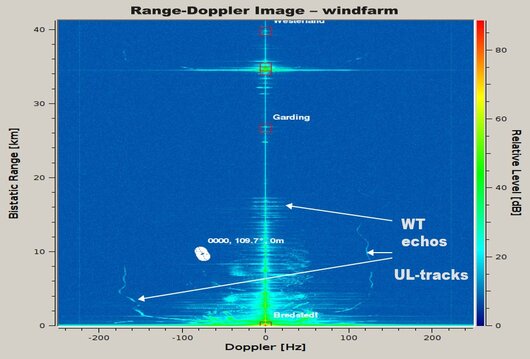Passive radar: How does the PARASOL system work?
A conventional radar system emits electromagnetic signals and then receives the echo reflected by an object in the detection range. The distance of the object is calculated from the time difference between the original signal and the echo.
In contrast, PARASOL uses the broadcast signals of the digital networks DVB-T and DAB+, which are available nationwide. Compared to other broadcast and communication signals, DVB-T signals are particularly suitable for the passive radar sensors because the broadcast transmitters bundle their signal energy at low altitudes below 1,000 metres and the emitted signal types and processing algorithms are well suited for distinguishing different objects. The transmitting mast can be at a distance of up to 80 kilometres, the PARASOL sensors receive both the original signal and its echo by a flying object. The system calculates the exact location of the detected object from the relation of the two signals.
The detection of the flying object
PARASOL permanently records the original signal. Over time, the electromagnetic signals generate a specific pattern like the bittings of a notched key. If an echo signal now hits the sensor, the specific pattern of the echo can be shifted backwards on the timeline of the received original signals until the two key patterns fit. Through this correlation calculation, the echo is assigned to the original signal. This turns the time difference between the original signal and its echo into a known quantity.
The time difference allows to calculate the extra distance travelled by the echo in contrast to the distance of the original signal. This leads to the deduction that the detected object can be located at any point that represents a diversion of the corresponding distance compared to the direct connecting line.
In three-dimensional space, the possible positions of the detected object now form the surface of an ellipsoid. Three sensors are necessary to determine the exact position: The flying object is located at the point where the three ellipsoids meet.

Velocity measurement
The velocity of the flying object results from the movement of the three ellipsoids’ intersection. However, the measurement of the velocity is verified by a second method using the Doppler effect of the echo signals. This phenomenon is well known. The sound of a train moving towards a person has a higher pitch than a train moving away. The reason is that, in the first case, the sound waves are compressed and, in the second case, are stretched. The PARASOL system makes use of this phenomenon and calculates the speed of the detected object based on the frequency shift of the electromagnetic waves.

